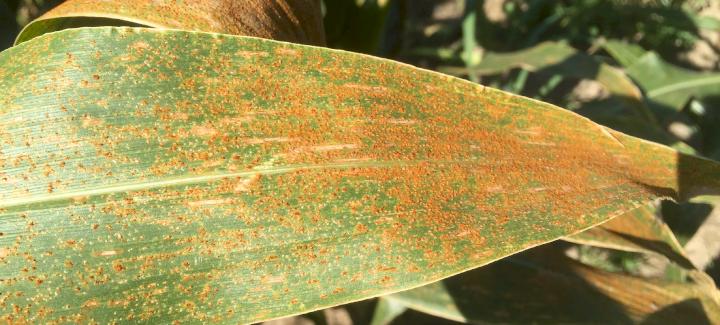
As of June 14, 95 percent of the country’s corn crop has emerged. Before corn begins to tassel, it’s important to scout for common corn diseases that occur this time of year, including southern rust. Southern rust can be found from the Mid-South to the northern Corn Belt, and can be exacerbated by high temperatures, humidity and strong winds.
Occurrence
According to the University of Nebraska-Lincoln’s Institute of Agriculture and Natural Resources, southern rust pustules can result from both urediniospores and teliospores. The institute notes, “The asexually produced urediniospores are dispersed long distances and are responsible for the spread of rust from the deep south to the Northern Great Plains in years where epidemics occur.” Because southern rust is a wind-borne fungus, it has potential to be a wide-spread problem for growers. Southern rust also favors high temperatures, ranging from 80 to 90-plus degrees Fahrenheit, in addition to areas with high humidity and moisture stress.
Detection
Scout for southern rust on the leaves of corn plants. Walk your fields, and look for areas of discoloration on the upper leaves. The fungus produces tan and/or orange lesions on the leaves, which are the southern rust pustules clustered closely together on the leaf surface or leaf sheaths. The fungus can also affect the stalk and husk of the plant. The lesions start small, producing a circular-type shape with a halo-like appearance. Once the fungus matures, the lesions spread and turn a brighter orangish-red.
Differentiating Between Other Corn Diseases
Tar spot: One way you can detect if it’s southern rust versus another corn disease called tar spot is if the spores rub off with your fingers. While both diseases can first appear as small black, pepper-like spots on leaves, southern rust spores can be wiped off upon touch; tar spot cannot. Learn more in this Ask the Agronomist video.
Common rust: It’s also easy to confuse southern rust with common rust. According to Purdue Extension, identifying the type of rust depends on the color, shape and location of the pustules. They note that common rust pustules typically appear on both the upper and lower leaf surfaces and are more elongated in shape and scattered across the leaf surface. Southern rust pustules can be primarily found on the upper leaf surface and are more round in shape and clustered together on the leaf surface. Southern rust lesions are also known to be smaller than common rust lesions. Learn more.
Your local university extension office can also help you determine exactly what fungus you’re dealing with. It’s best to extract and send whole plant samples as soon as you detect the disease. The lab can then examine the whole plant from roots to foliage to determine what disease is present and the best action to mitigate it.
Management
Southern rust can be devastating to yields, so you need to determine the level of infection before taking next steps. If symptoms have reached a certain threshold, your situation may warrant a foliar fungicide. Purdue Extension notes, “In high-value corn production, a few pustules on 50 percent of observed plants could trigger a fungicide application.”
When considering a fungicide for management of southern rust, pay close attention to the timing and application guidelines of that fungicide in addition to the upcoming forecast. Ohio State University Extension notes that fungicide applications need to be made as soon as the first pustules are observed for best results. Spraying when the disease is first detected and confirmed as southern rust can help reduce the spread of the disease as the spores move from plant to plant with the wind. They also note it’s important to start applications with the latest planted fields first because they are higher risk for yield damage. When fungicides are applied, growers need to watch their fields after residual control of that particular fungicide has worn off to ensure the disease does not return.
If you suspect southern corn rust in your fields, enlist the assistance of your local Stine agronomist to help confirm the disease and discuss your mitigation options. You can also consult the Corn ipmPIPE tool to see if there’s a report of southern corn rust in your county to help you prepare for the potential risk of the disease reaching your fields.
Related Articles
-

Start strong with Stine®: Maximizing your 2026 potential
January 2026 in Agronomy
-

Stine® to offer Syngenta’s Victrato® soybean seed treatment in 2026
December 2025 in Agronomy
-

Use Stine’s XP® seed treatments to prevent early injury to your crops
December 2025 in Agronomy
-

Understanding Stine’s enhanced oil profile soybeans
December 2025 in Agronomy



